Serving 688 students in grades 7-8, Bernal Intermediate ranks in the top 30% of all schools in California for overall test scores (math proficiency is top 50%, and reading proficiency is top 50%).
The percentage of students achieving proficiency in math is 40% (which is higher than the California state average of 33%). The percentage of students achieving proficiency in reading/language arts is 59% (which is higher than the California state average of 47%).
The student:teacher ratio of 24:1 is higher than the California state level of 21:1.
Minority enrollment is 85% of the student body (majority Hispanic), which is higher than the California state average of 80% (majority Hispanic).
Quick Stats (2025)
- Grades: 7-8
- Enrollment: 688 students
- Student:Teacher Ratio: 24:1
- Minority Enrollment: 85%
- Overall Testing Rank: Top 30% in CA
- Math Proficiency: 40% (Top 50%)
- Reading Proficiency: 59% (Top 30%)
- Science Proficiency: 40% (Top 30%)
- Source: National Center for Education Statistics (NCES), CA Dept. of Education
Top Rankings
Bernal Intermediate ranks among the top 20% of public schools in California for:
Category
Attribute
Diversity
School Overview
Bernal Intermediate's student population of 688 students has declined by 7% over five school years.
The teacher population of 29 teachers has declined by 12% over five school years.
Grades Offered
Grades 7-8
Total Students
688 students
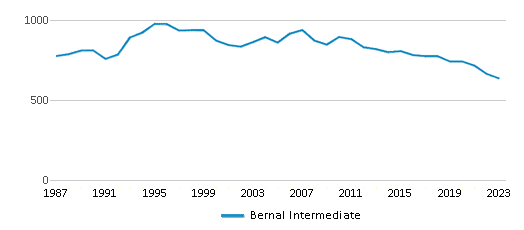
Gender %
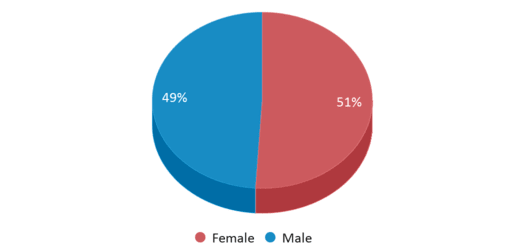
Total Classroom Teachers
29 teachers
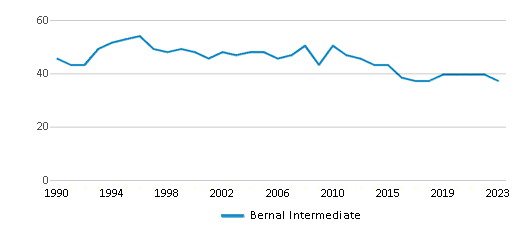
Students by Grade
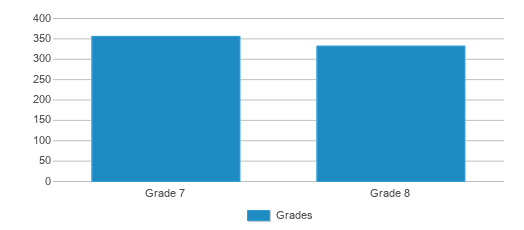
School Calendar
School Rankings
Bernal Intermediate ranks within the top 30% of all 9,602 schools in California (based off of combined math and reading proficiency testing data).
The diversity score of Bernal Intermediate is 0.70, which is more than the diversity score at state average of 0.63. The school's diversity has stayed relatively flat over five school years.
Overall Testing Rank
#2579 out of 9602 schools
(Top 30%)
(Top 30%)
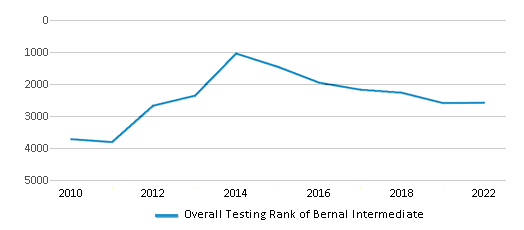
Math Test Scores (% Proficient)
40%
33%
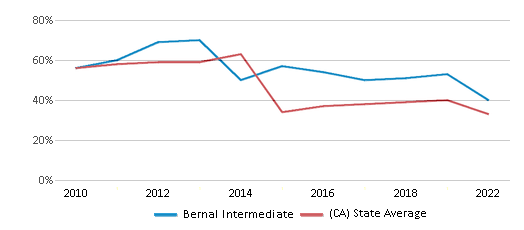
Reading/Language Arts Test Scores (% Proficient)
59%
47%
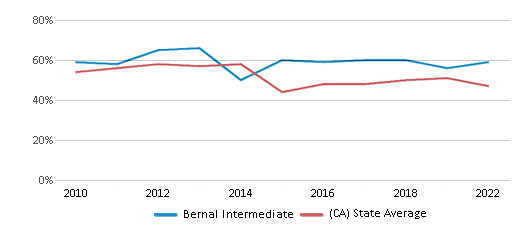
Science Test Scores (% Proficient)
40%
29%
Student : Teacher Ratio
24:1
21:1
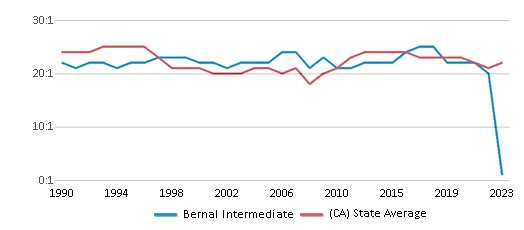
American Indian
n/a
1%
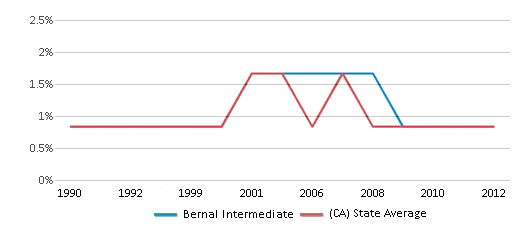
Asian
28%
12%

Hispanic
45%
56%
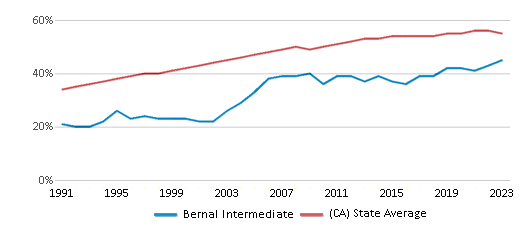
Black
3%
5%
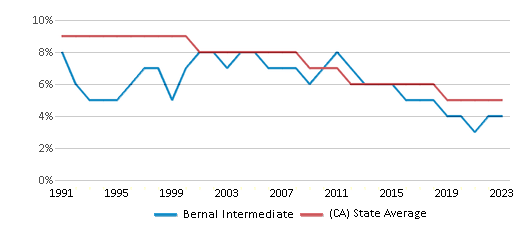
White
15%
20%
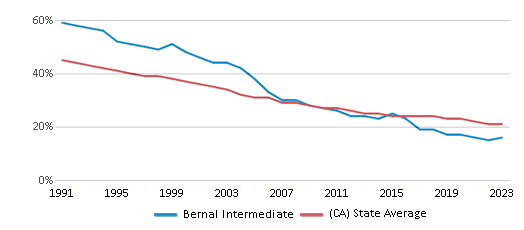
Hawaiian
1%
n/a
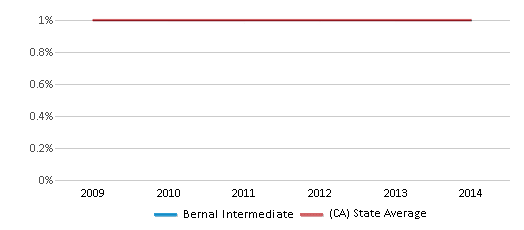
Two or more races
8%
6%
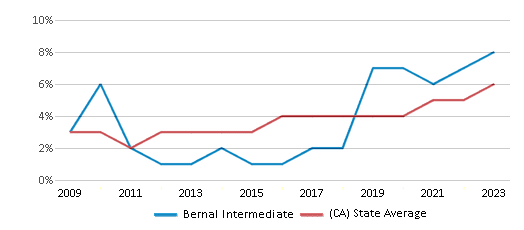
All Ethnic Groups
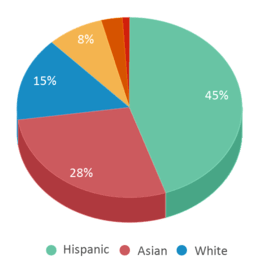
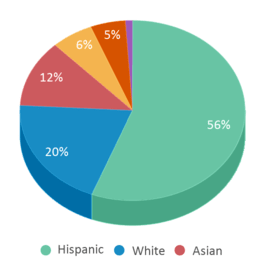
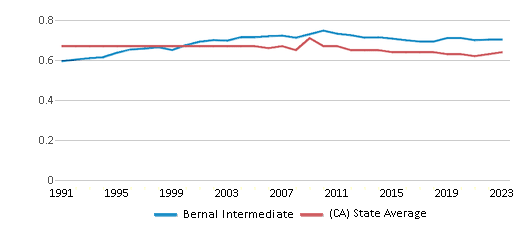
Eligible for Free Lunch
36%
54%
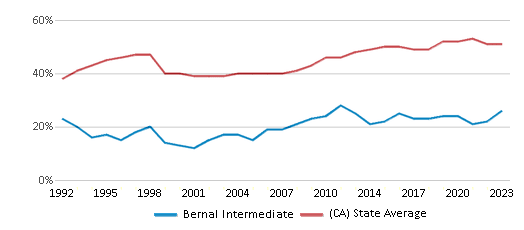
Eligible for Reduced Lunch
3%
8%
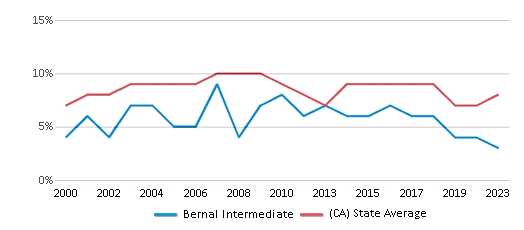
School Statewide Testing
School District Name
Source: National Center for Education Statistics (NCES), CA Dept. of Education
Profile last updated: 02/09/2025
Frequently Asked Questions
What is Bernal Intermediate's ranking?
Bernal Intermediate is ranked #2579 out of 9,602 schools, which ranks it among the top 30% of public schools in California.
What schools are Bernal Intermediate often compared to?
Bernal Intermediateis often viewed alongside schools like Herman (Leonard) Intermediate by visitors of our site.
What percent of students have achieved state testing proficiency in math and reading?
40% of students have achieved math proficiency (compared to the 33% CA state average), while 59% of students have achieved reading proficiency (compared to the 47% CA state average).
How many students attend Bernal Intermediate?
688 students attend Bernal Intermediate.
What is the racial composition of the student body?
45% of Bernal Intermediate students are Hispanic, 28% of students are Asian, 15% of students are White, 8% of students are Two or more races, 3% of students are Black, and 1% of students are Hawaiian.
What is the student:teacher ratio of Bernal Intermediate?
Bernal Intermediate has a student ration of 24:1, which is higher than the California state average of 21:1.
What grades does Bernal Intermediate offer ?
Bernal Intermediate offers enrollment in grades 7-8
What school district is Bernal Intermediate part of?
Bernal Intermediate is part of Oak Grove Elementary School District.
In what neighborhood is Bernal Intermediate located?
Bernal Intermediate is located in the South San Jose neighborhood of San Jose, CA. There are 19 other public schools located in South San Jose.
School Reviews
5 12/8/2017
I went to this school and graduated in 1982. Best times of my life.
5 7/9/2007
I went there 2 years ago.
a. there are NO academic programs, unless you are like, brilliant. that is where all the adult attition goes.
b. there is NO availability for extracurricular activites. AT ALL.
c. You have to be really great at everything to get any type of award. i was a b+ student and i NEVER got recignized for anything.if they had pushed me (or even paid attition to me) i know i could have been an A student.
d. the teacher to student ratio is crazy. there should be far less students per classroom. the bathrooms are NASTY (they always smelled bad). the janator was pretty cool though (kevin, he was awesome =]])
e. no parents care about that school either. nobody even shows up for parent teacher night.
it was a good social school, though if you got in the right clique.sorry if it was complany. the school was pretty okay. the adults just need to be more involved with EVERYBODY.
Review Bernal Intermediate. Reviews should be a few sentences in length. Please include any comments on:
- Quality of academic programs, teachers, and facilities
- Availability of music, art, sports and other extracurricular activities
Recent Articles

What Is A Charter School?
Explore the world of charter schools in this comprehensive guide. Learn about their history, how they operate, and the pros and cons of this educational innovation. Discover key facts about charter schools, including admission policies, demographics, and funding, as well as what to look for when considering a charter school for your child.

10 Reasons Why High School Sports Benefit Students
Discover the 10 compelling reasons why high school sports are beneficial for students. This comprehensive article explores how athletics enhance academic performance, foster personal growth, and develop crucial life skills. From improved fitness and time management to leadership development and community representation, learn why participating in high school sports can be a game-changer for students' overall success and well-being.

February 05, 2025
Understanding the U.S. Department of Education: Structure, Impact, and EvolutionWe explore how the Department of Education shapes American education, from its cabinet-level leadership to its impact on millions of students, written for general audiences seeking clarity on this vital institution.









